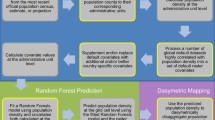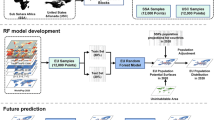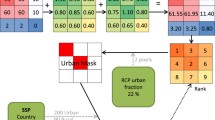Abstract
Spatially explicit population data can play an important role in studies on environment and sustainability. Several gridded datasets on the present population exist, but global data on future populations are largely lacking. This paper presents a dataset covering three global population forecasts for the period 1990–2100 at 0.5-degrees resolution. The basis for these forecasts is the SRES scenarios developed for the IPCC climate-modeling framework. In addition, a gridded dataset of urban and rural populations for the period 1990–2050 is presented. To illustrate how the datasets can be used, future changes in population density and urbanization were analyzed for some of the world’s major river basins. This analysis shows that the population density in the Ganges basin, which is already very high, is likely to increase considerably. The highest future increase rates were found in some African and Middle-Eastern basins. The population dataset for 2015 was compared with one previously published gridded dataset. The comparison shows some differences in population density, mainly in small, highly urbanized coastal river basins, while for large basins, the two datasets agree fairly well. We hope that the datasets here presented will prove to be a useful resource also for other researchers of global environmental change and sustainable development.








Similar content being viewed by others
References
Adams, J. (1968). A population map of West Africa. Graduate School of Geography Discussion Paper No. 26. London: London School of Economics.
Balk, D., Brickman, M., Anderson, B., Pozzi, F., & Yetman, G. (2005). Estimates of future global population distribution to 2015. Palisades, NY: CIESIN, Columbia University. Available at: http://sedac.ciesin.columbia.edu/gpw/documentation.jsp#.
Balk, D., Pozzi, F., Yetman, G., Deichmann, U., & Nelson, A. (2004). The distribution of people and the dimension of place: Methodologies to improve the global estimation of urban extents. Draft version. Palisades, NY: CIESIN, Columbia University. Available at: http://beta.sedac.ciesin.columbia.edu/gpw/documentation.jsp.
Balk, D., & Yetman, G. (2004). The global distribution of population: Evaluating the gains in resolution refinement, documentation for GPWv3. Palisades, NY: CIESIN, Columbia University. Available at: http://beta.sedac.ciesin.columbia.edu/gpw/documentation.jsp.
Benkovitz, C. M., Scholtz, M. T., Pacyna, J., Tarrasón, L., Dignon, J., Voldner, E. C., Spiro, P. A., Logan, J. A., & Graedel, T. E. (1996). Global gridded inventories of anthropogenic emissions of sulfur and nitrogen. Journal of Geophysical Research, 101( D22), 29239–29253.
Chapelon, N., Douville, H., Kosuth, P., & Oki, T. (2002). Off-line simulation of Amazon water balance: A sensitivity study with implications for GSWP. Climate Dynamics, 19, 141–154.
CIESIN (Center for International Earth Science Information Network) (2002a). Country-level population and downscaled projections based on the B2 scenario, 1990–2100, [digital version]. Palisades, NY: CIESIN, Columbia University. Available at http://www.ciesin.columbia.edu/datasets/downscaled. (Downloaded 2005/11/28).
CIESIN (Center for International Earth Science Information Network) (2002b). Country-level population and downscaled projections based on the A1, B1 and A2 Scenarios, 1990–2100, [digital version]. Palisades, NY: CIESIN, Columbia University. Available at http://www.ciesin.columbia.edu/datasets/downscaled. (Downloaded 2005/11/28).
CIESIN (Center for International Earth Science Information Network), Columbia University, United Nations Food and Agriculture Programme (FAO), & Centro Internacional de Agricultura Tropical (CIAT) (2005a). Gridded population of the world: Future estimates, 2015 (GPW2015): Population grids. Palisades, NY: Socioeconomic Data and Applications Center (SEDAC), Columbia University. Available at http://sedac.ciesin.columbia.edu/gpw. (Downloaded 2006/04/12).
CIESIN (Center for International Earth Science Information Network), Columbia University, & Centro Internacional de Agricultura Tropical (CIAT) (2005b). Gridded population of the world version 3 (GPWv3): Population grids. Palisades, NY: Socioeconomic Data and Applications Center (SEDAC), Columbia University. Available at http://sedac.ciesin.columbia.edu/gpw. (Downloaded 2006/04/12).
Cohen, B. (2004). Urban growth in developing countries: A review of current trends and a caution regarding existing forecasts. World Development, 32(1), 23–51.
Dobson, J. E., Bright, E. A., Coleman, P. R., Durfee, R. C., & Worley, B. A. (2000). LandScan: A global population database for estimating population at risk. Photogrammetric Engineering and Remote Sensing, 66(7), 849–857.
Gaffin, S. R., Rosenzweig, C., Xing, X., & Yetman, G. (2004). Downscaling and geo-spatial gridding of socio-economic projections from the IPCC Special Report on Emission Scenarios (SRES). Global Environmental Change, 14, 105–123.
Goldewijk, K. K. (2005). Three centuries of global population growth: A spatial referenced population (density) database for 1700–2000. Population and Environment, 26(4), 343–367.
Hales, S., de Wet, N., Maindonald, J., & Woodward, A. (2002). Potential effect of population and climate changes on global distribution of dengue fever: An empirical model. The Lancet, 360(9336), 830–834.
Hay, S. I., Guerra, C. A., Tatem, A. J., Noor, A. M., & Snow, R. W. (2004). The global distribution and population at risk of malaria: Past, present, and future. The Lancet Infectious Diseases, 4, 327–336.
Honeycutt, D. & Wojcik, J. (1990). Development of a population density surface for the conterminous United States. Proceedings GIS/LIS ‘90 (Anaheim), 1, 484–496.
IOG (Institute of Geography, Chinese Academy of Sciences) (1987). The population atlas of China. Hong Kong: Oxford University Press.
Johns, T., Durman, C., Banks, H., Roberts, M., McLaren, A., Ridley, J., Senior, C., Williams, K., Jones, A., Keen, A., Rickard, G., Cusack, S., Joshi, M., Ringer, M., Dong, B., Spencer, H., Hill, R., Gregory, J., Pardaens, A., Lowe, J., Bodas-Salcedo, A., Stark, S., & Searl, Y. (2005). HadGEM1-Model description and analysis of preliminary experiments for the IPCC fourth assessment report. Hadley Centre Technical Note No. 55, Met Office, Exeter, UK. Available at http://www.hadleycentre.com/research/hadleycentre/pubs/HCTN/HCTN_55.pdf.
Lutz, W. (Ed.) (1996). The future population of the world. What can we assume today? (Revised and Updated Edition 1996). International Institute for Applied Systems Analysis (IIASA), BK-96-003, Laxenburg, Austria.
Martin, G. M., Dearden, C., Greeves, C., Hinton, T., Inness, P., James, P., Pope, V. D., Ringer, M. A., Stratton, R. A., & Yang, G. Y. (2004). Evaluation of the atmospheric performance of HadGAM/GEM1. Hadley Centre Technical Note No. 54, Met Office, Exeter, UK. Online at http://www.hadleycentre.com/research/hadleycentre/pubs/HCTN/HCTN_54.pdf.
Meigh, J. R., McKenzie, A. A, & Sene, K. J. (1999). A grid-based approach to water scarcity estimates for eastern and southern Africa. Water Resources Management, 13, 85–115.
Milly, P. C. D., & Dunne, K. A. (2002). Macroscale water fluxes: 1. Quantifying errors in the estimation of basin mean precipitation. Water Resources Research, 38(10, 1205), 23.1–23.14.
Nakicenovic, N., & Swart, R. (Eds.) (2000). Special report on emissions scenarios: A special report of working group III of the intergovernmental panel on climate change. Cambridge: Cambridge University Press, 612 pp.
Oki, T., Agata, Y., Kanae, S., Saruhashi, T., Yang, D., & Musiake, K. (2001). Global assessment of current water resources using total runoff integrating pathways. Hydrological Sciences Journal, 46, 983–996.
Oki, T., & Kanae, S. (2006). Global hydrologic cycle and world water resources. Science, 313(5790), 1068–1072.
Oki, T., & Sud, Y. C. (1998). Design of total runoff integrating pathways (TRIP) a global river channel network. Earth Interactions, 2, 1–37.
Rhind, D., Evans, I., & Visvalingam, M. (1980). Making a national atlas of population by computer. Cartographic Journal, 17, 1–11.
Salvatore, M., Pozzi, F., Ataman, E., Huddleston, B., & Bloise, M. (2005). Mapping global urban and rural population distributions. Rome: FAO.
Small, C., Gornitz, V., & Cohen, J. E. (2000). Coastal hazards and the global distribution of human population. Environmental Geosciences, 7(1), 3–12.
Smith, S. V., Swaney, D. P., Talaue-McManus, L., Bartley, J. D., Sandhei, P. T., McLaughlin, C. J., Dupra, V. C., Crossland, C. J., Buddemeier, R. W., Maxwell, B. A., & Wulff, F. (2003). Humans, hydrology, and the distribution of inorganic nutrient loading to the ocean. BioScience, 53(3), 235–245.
Tobler, W., Deichmann, U., Gottsegen, J., & Maloy, K. (1995). The global demography project. Technical Report TR-95-6. National Center for Geographic Information and Analysis. Santa Barabara: Department of Geography, University of California.
Tobler, W., Deichmann, U., Gottsegen, J., & Maloy, K. (1997). World population in a grid of spherical quadrilaterals. International Journal of Population Geography, 3, 203–225.
UNEP/GRID (2006). UNEP/GRID spatial data clearinghouse. Available at: http://grid2.cr.usgs.gov/datasets/datalist.php.
van Vuuren, D. P., & O’Neill, B. C. (2006). The consistency of IPCC’s SRES scenarios to recent literature and recent projections. Climatic Change, 75, 9–46.
Vörösmarty, C. J., Green, P., Salisbury, J., & Lammers, R. B. (2000). Global water resources: Vulnerability from climate change and population growth. Science, 289, 284–288.
Yue, T., Wang, Y., Liu, J., Chen, S., Qiu, D., Deng, X., Liu, M., Tian, Y., & Su, B. (2005). Surface modeling of human population distribution in China. Ecological Modelling, 181, 461–478.
Zhang, L., & Zhao, S. X. B. (1998). Re-examining China’s “Urban” concept and the level of urbanization. China Quarterly, 154, 330–381.
Acknowledgements
The research presented in this paper is part of a project funded by the Japan Science and Technology Agency (JST) under its CREST (Core Research on Evolutionary Science and Technology) research promotion scheme. We would also like to acknowledge the valuable comments we received from an anonymous reviewer.
Author information
Authors and Affiliations
Corresponding author
Rights and permissions
About this article
Cite this article
Bengtsson, M., Shen, Y. & Oki, T. A SRES-based gridded global population dataset for 1990–2100. Popul Environ 28, 113–131 (2006). https://doi.org/10.1007/s11111-007-0035-8
Received:
Accepted:
Published:
Issue Date:
DOI: https://doi.org/10.1007/s11111-007-0035-8




